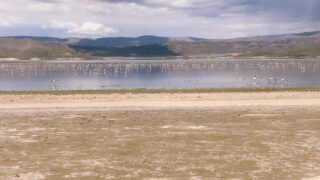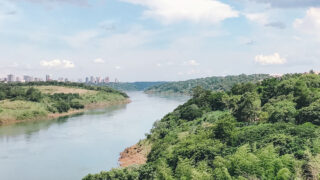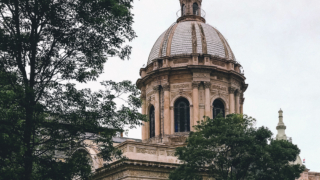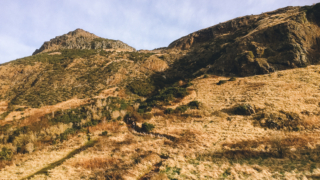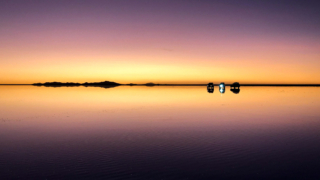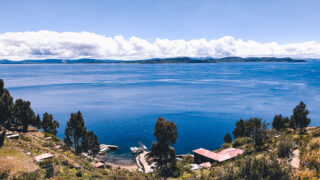Out of all the incredible places, this world has to offer the Amazon rainforest is one that will live in your memories forever. The igniting noise levels of birds singing, monkeys howling, crickets chirping, frogs croaking, rain downpour, and leaves rattling in the wind is unlike anything you could experience anywhere else. Never would I have thought that I would walk in jaguar’s footprints or swim in waters piranhas and caimans call their home. Yasuni National Park, considered the most bio-diverse region on Earth, is an Ecuadorian rainforest reserve and offers all that.
There are many different ways the Amazon can be explored from guided navigating on a boat along the Shiripuno River to walks through thick jungle terrain. Nights can be spent in lodges or DIY tents. Whatever you choose you are guaranteed to be overwhelmed by the variety of smells, sounds, patterns, and endless views this unique place has to offer. Trying to figure out how to get to Yasuni National Park, what to expect, how much it costs, and which animal I couldn’t believe my eyes seeing in the Amazon? Read, plan, explore!

Post Contents
WHERE IS YASUNI NATIONAL PARK
Yasuni National Park can be found in between the Ecuadorian Andes Mountains, the Western Amazon basin, and the Equator. The lodges are located along the Shiripuno River at a safe distance from a Waorani Ethnic Reserve where tribe members live in voluntary self-isolation, not to mistake for the communities that you will be meeting. The main hub to reach this Amazonian reserve is Coca a rundown town. Another popular Ecuadorian park nearby is Cuyabeno National Park. The only person I know of visiting this park saw sloths and an anaconda dangling from a tree welcoming the canoe riding visitors with a gentle hiss.
WHY CHOSE YASUNI NATIONAL PARK
Sitting on top of volatile oil reserves the area has recently been opened for oil drilling. A concerning development putting a rich overlapping diversity of plants, amphibians, birds, and mammal species at risk. But to the contrary of what one might expect tourism helps to spread awareness of this issue and protect the area.
Another point to consider is that Ecuadorian Amazon lodges are often overlooked with Iquitos in Peru and Leticia in Colombia being most overrun with backpackers. The first being most expensive alongside Brazilian lodges and the latter being cheapest alongside Bolivian lodges. Bearing this in mind I was hoping for off the beaten path lodges in Ecuador at a mid-price range. My gut instinct was spot on and two of us had Shiripuno Lodge amid the thick jungle to ourselves for 5-Days.
WHY NOT TO CHOSE YASUNI NATIONAL PARK
It is important to bear in mind that nature cannot and should not be controlled. Spotting animals other than caimans and turtles in close proximity is mere luck. Although we did see different monkey species hanging from branches, flying skilfully from tree to tree, getting a good close look is difficult. The lack of habitat invasion and space to roam the Amazon provides the wildlife with room to escape.
The Amazon is hopefully going to stay a thick, overgrown, untouched entwined beauty of plants. For that reason, spotting animals is not only a skill but also difficult. Guides will do their best to enrich your experience by showing you as much wildlife as safely and respectfully possible. If your sole goal is to see many animals within a short amount of time I suggest habitats where wildlife is more used to humans and will hang around, quite literally, rather than flee the scene. Then nature tours in the outskirts of the Amazon or visiting the pampa around Rurrenabaque will be your best shot.

YASUNI NATIONAL PARK TOURS
The first time when all the chirping noise has been drowned out by heavy rainfall and you are soaked to the core, no poncho will save you, followed by sun rays fighting their way through the rare gaps within the dense canopies you realise that there is no other experience quite like the Amazon. I know I keep on saying this, but it’s true!
Yasuni National Park tours range from 3 to 8 days. Lodges keep visitor numbers small to avoid disturbance of nature. Therefore, accommodations tend to sell out. Amazon tours can be booked in Coca or directly through the lodges’ websites in advance. In contrast to my usual travel planning, I booked my stay two months prior. Although, as previously mentioned, the demand in November was low and there were only two of us.
More expensive tours tend to have an English-speaking guide, better food, and smaller groups. From a sustainable standpoint, I did not want a bigger group than five people nor electricity.
What’s Included In The Tours.
Most tours are a mix of walks and canoe floats unless you book an on-water experience only. These tours sometimes “cater to see specific species”. But remember animals roam the Amazon freely and specific sightings can’t be guaranteed. I must say that the many different tours offer pretty much the same experience. Something you can expect from all tours is meeting Waorani Tribe People, watch hundreds of colourful butterflies dance over sandbanks, see a mix of birds, mammals, amphibians, and reptiles, suffer many mosquito bites, and maybe even face plant in the mud.
There will be a sunrise and night-time canoe or walking experience resulting in the majority of your stay’s sightings. We had twelve baby caiman eyes glaring back at our torches. Some of the tours include tubbing, a natural mud bath, swimming, piranha fishing, and a visit to the Waorani community to learn about their traditions, cooking customs, and how to use hunting blowguns.
Overall, when choosing a tour it is important to consider your fitness. The humidity and heat can be exhausting and although most of the walking will be in the shade of the jungle the overgrown “paths” and muddy ground make hiking difficult.
How Many Days To Choose?
The activities of the 3 to 8-Day stays aren’t majorly different however the longer you spend in the Amazon the more animals you are guaranteed to see. Moreover, the disconnection from society also has a mind-calming effect.
Design Your Stay.
Anyone on the more adventurous side looking for a special memory should reach out and enquire about a trip designed for your liking. I have friends who built their own hut and woke up to pouring rain leaking through the roof. As with any Amazonian adventure, most lodges and guides are flexible during periods of low demand and happily create an itinerary in accordance with your preferences in terms of prolonged stay, ways of exploring, and hands-on experiences.
Volunteering Programs.
There are 4 and 8-week volunteering programs with the Waorani Community you can partake in through the Shiripuno Research Centre. These programs revolve around education, maintenance, and conservation.
The Wildlife You Get To See.
Let’s get to everyone’s most pressing question. But what did you actually see? With more than 4,000 plants, 200 mammals, 650 bird, 120 reptiles, 147 amphibians, and 600 freshwater fish species you are guaranteed to see a variety of animals, some might even surprise you!
As the most biodiverse place in the World, you are guaranteed to see some wildlife. What that might be depending on your luck. The animals we saw were many adult and baby caiman, tarantulas, macaws, parrots, toucans, Humboldt’s woolly monkeys, squirrel monkeys, Ecuadorian white-fronted capuchin monkeys, Napo Saky monkeys and Colombian red howler monkeys, a tapir’s butt, yellow-spotted Amazon River turtles, different types of birds, crabs, a dart frog, and even a deer. Yes, a deer! Other animals commonly spotted are squirrel monkeys, piranhas, sloths, anacondas, pink dolphins, and on extremely rare occasions jaguars, pumas, and ocelots. Like I have mentioned previously we did see “fresh” footprints of a jaguar and a puma. I also had an incident with a frog desperately trying to jump through the mosquito net into my bed. At first, I thought it was a snake. You can imagine the relief I felt!
HOW TO BOOK A TOUR
Tours can be booked directly with the lodges in advance. I believe this is the best way to make sure that guides, cooks, and drivers are paid fairly. Anyone who would rather book through a trusted tour operator can shop around in Quito or Coca. Although, I suggest having something lined up before reaching Coca. Prices for a multi-day stay depend on the lodge and range from around $ 440 to over $ 2,000 per person.
Included in the tour price is the transportation to and from Coca, meals, an either Spanish or English speaking native naturalist guide, and rubber boots up to size 43.
Not included in the overall cost is the transportation from Quito to Coca, soft or alcoholic drinks, and staff tips.
TIP │ Sign up to lodge newsletters for discounts.
YASUNI NATIONAL PARK LODGES
Wondering how to visit Yasuni National Park? There are a couple of accommodations to choose from. All lodges cater for food restrictions if advised in advance. I was looking for a lodge that does not provide hot showers and electricity to, first of all, protect the Amazon rainforest and second of all get more of a true experience. But I appreciate not everyone shares these views. Therefore, I have listed alternatives to my lodge of choice – Shiripuno Lodge.
Shiripuno Lodge │ Authentic Experience
Shiripino Lodge’s philosophy is to encourage visitors to explore the wilderness with minimal environmental impact. The lodge can be found a 4-hour motorized canoe ride into the depths of the Amazon. The lodge is located on the edge of the Shiripuno River. Although officially there is no electricity the main house had an emergency plug. Prices have to be requested through their website. We paid $ 575 per person for 5-Days in an ensuite double room, plus a Waorani community entrance fee of $ 20.

Sani Lodge │ Community Owned
Another lodge within the actual Yasuni reserved and 100% owned by the Waorani community is Sani Lodge. The experiences offered are authentic and range from 4-Days for $825 to 8-Days for $1,661. Types of accommodations are rooms or for true adventurer tents.
Yarina Lodge │ Budget Friendly
Prices per person start at $ 440 for 3-Days to $650 for 5-Days. The 20 double and dorm cabin lodge provides 24-hour electricity and hot water on the outskirts of this natural wonder.
Napo Wildlife Center │ Award Winner
A winner of the 2018 Condé Nast Johansens Award for Best Green Practices and Sustainability this lodge offers wildlife and cultural tours as well as combinations. Prices range from $ 1,332 for four days up to $ 2,994 for 8-days.
Sacha Lodge │ Luxury
This is the most hotel feel you can get without taking it too far. The lodge has built towers and raised paths on the edge of Yasuni for unique jungle perspectives. Prices per person start at $ 1,390 for 4-nights in a 4-bed to $ 2,190 for 5-nights in a double. Hot showers with rain forest views are provided and the lodge has an in-house restaurant and bar.
HOW TO GET TO YASUNI NATIONAL PARK
Coca is the hub for reaching Yasuni National Park and can easily be reached by local bus or by a regular flight from Quito. The nature around Coca is incredibly beautiful if you have the time I suggest travelling by local bus instead of plane.
How To Get To Coca From Quito.
By Plane.
The more expensive and quickest way to get from Quito to Coca is by 40-minute flight for around $ 70- 100. Two airlines are serving this route Avianca and LATAM with the charging extra for checked baggage. Tours tend to start at 10.30 am for anyone crazy enough to fly in the morning.
By Local Bus.
The bus Number 30 from Quito’s Terminal Terrestre Quitumbe to Coca takes 6-hours and is one of the most scenic bus journeys I have ever done. The winding roads lead through beautiful mountainous scenery, past erupting volcano smoke pillars to flames showing their force in the form of oil distilleries.
Tickets with bus operator Baños cost $ 12. The toilet was locked throughout the journey and there was only minimal air conditioning. Buses run about every hour from different companies, but it is recommended to leave early unless you are aiming for a night bus. If you do not walk all the way around to the National Bus Terminal entrance and instead enter at the bus entrance for local busses within Quito you have to pay entry to access the terminal. To avoid this additional charge, go to the terminal Quitumbre Terrestre entrance at the back which is for long-distance buses. If you stand in front of the terminal walk alongside the left side of the building to get to the back end where the entrance is. Let me know in the comments if this has changed.
How To Get To Coca From Baños.
The bus journey via Tena or Ambato takes 10-hours. From Baños to Coca is a little trickier to plan since busses to Tena and Ambato from Baños are fairly regular various the onward busses to Coca run on specific days and about every two hours until the early afternoon. I highly advise checking timetables at the bus terminal in advance.
I travelled from Coca to Tena for $ 8.75 and then continued to Baños for an additional $ 4. The bus company was called Valle de Quijos which I would not recommend, my bus was stopped near Tena by police. After a short-heated argument, we were told to find our own way into town.

If this happens to you bear in mind that the bus travels on the main road operated by local busses into town. These can be flagged down for only $0.30. The bus assistant let me know when to get off. The regional bus terminal was only a two-minute walk away from the crossing I was dropped at. Thank god for the maps.me app, and my incredible Spanish teacher! Spanish speakers can share a taxi with other stranded local passengers
BEST TIME TO VISIT
The nature of the climate in the Amazon is rainy, humid, and warm all year round. Temperatures being at their lowest at 26 C and reaching up to 32 C with January to March seeing the least amount of downpour. The rain becomes more frequent from March to July. The rest of the year the weather fluctuates from heavy downpour one minute to bright sunshine the next.

WHAT TO PACK
The rainforest doesn’t’ have its name for no reason. Downpours and cool rainstorms can happen unexpectedly at any time, so be prepared! Gear to bring is a lightweight rain jacket, rain cover for your backpack, long-sleeved and legged (linen) clothing, light coloured clothing, layering pieces in case the nights are cool, hiking boots, high factor sun cream, swim costumes, a head torch, fully charged power bank, and if you want to make the most of your visit binoculars.
I want to emphasise that the mosquito repellent needs to be for tropical climates else you will be eaten alive. Guides have also told me that mosquitoes are less attracted to light coloured clothing.
Tip │ Nopikex mosquito repellent was the best out of my experience. I had bought the soap bar like version not the spray in Colombia. Although the repellent is readily available around South America.
SAFETY
Throughout my time I only had concerns for my safety once when a deer sprinted past. The initial fear quickly turned into confusion and then delight. The main safety concern is mosquitos. Therefore, a good repellent is vital. Some lodges require proof of yellow fever vaccinations before booking. Speak to your general practitioner to identify any vaccinations that might be required.
Ready to get lost in the most biodiverse reserve on Mother Earth? Also, do you remember the animal I saw in Yasuni National Park that I couldn’t believe my eyes seeing? It was a deer.
Now go ahead and explore! Try not to lose your towel.
Pin it for later!


























